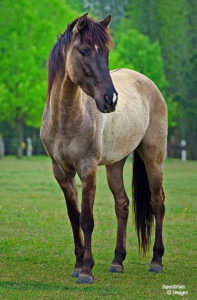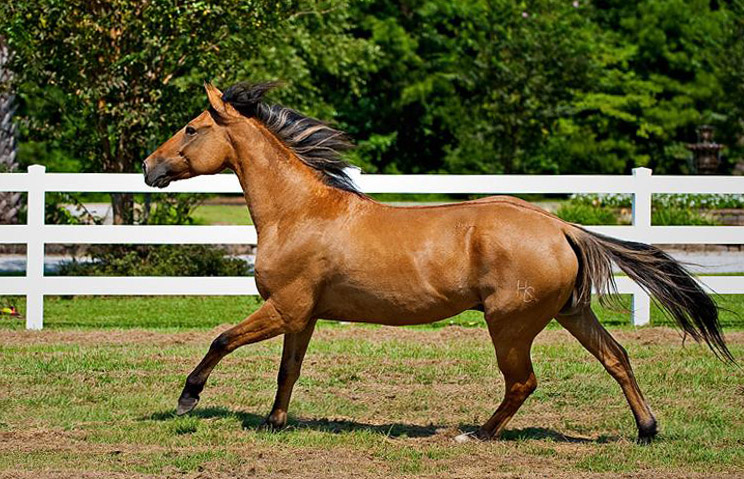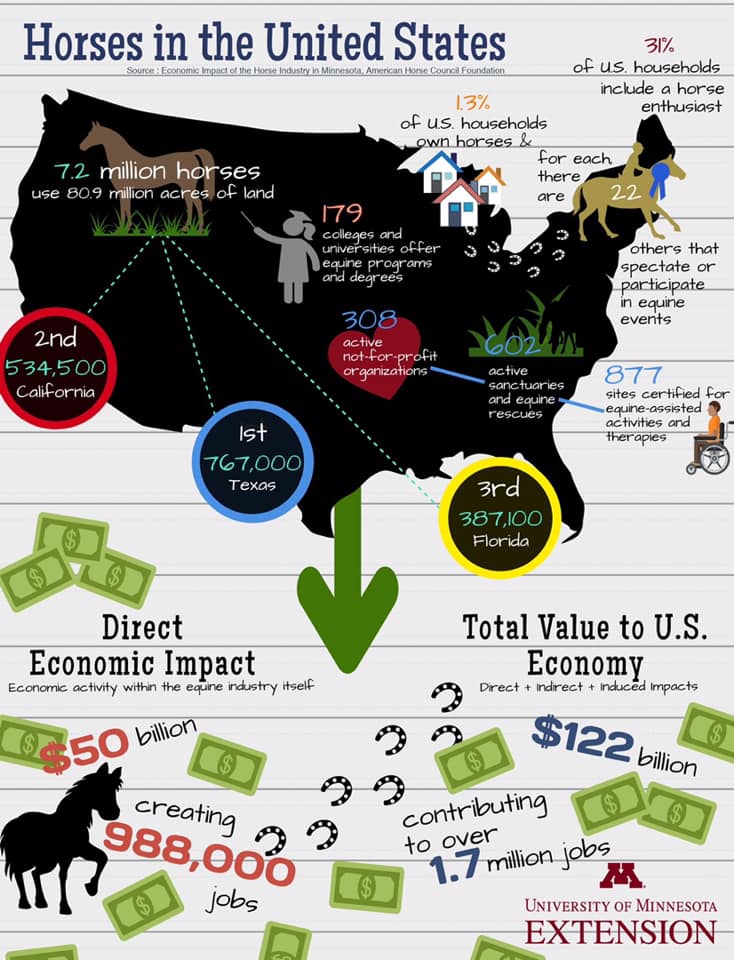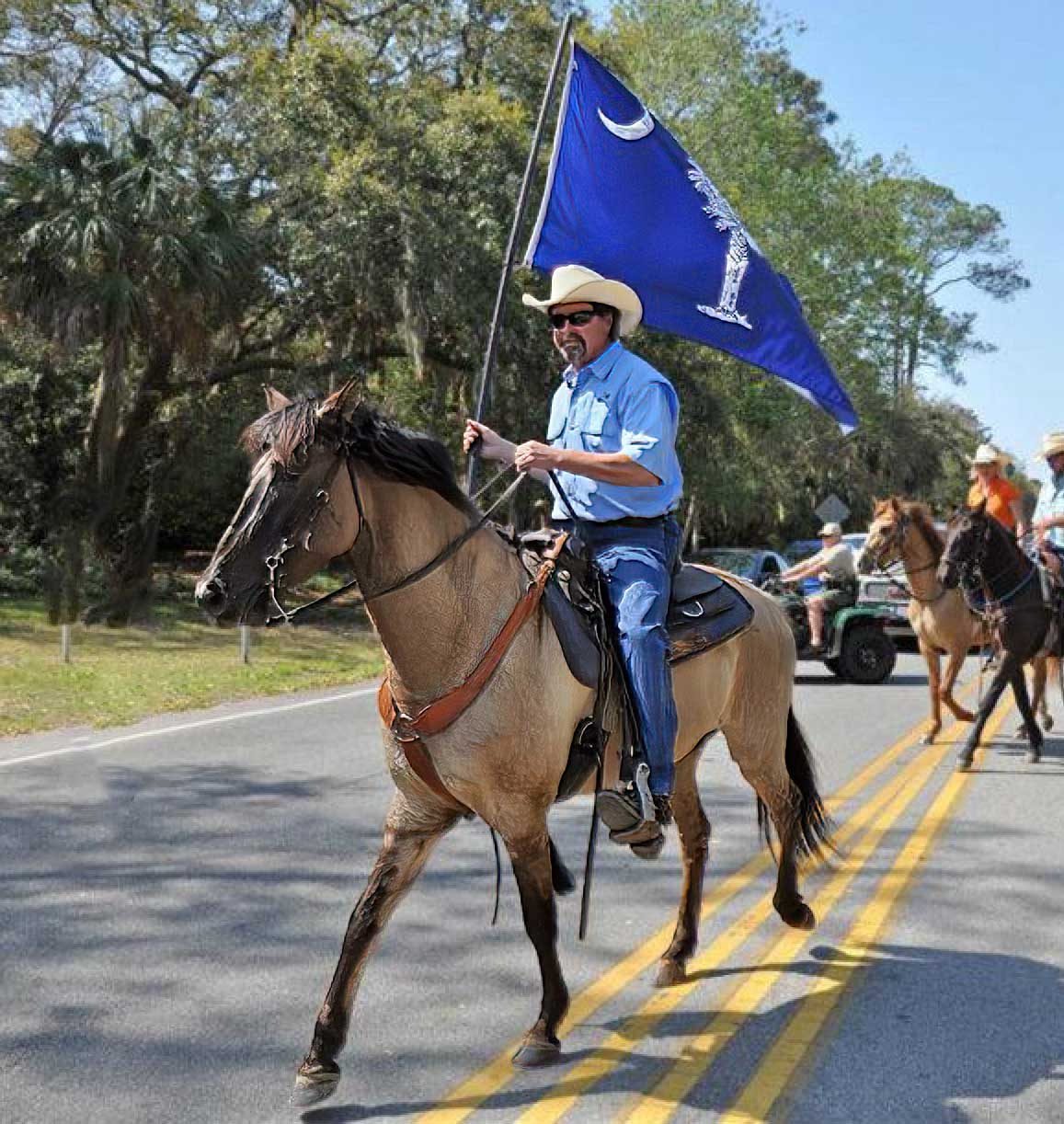 The name “Tacky” is derived from the English word for “cheap” or “common.” For most of their history, Marsh Tackies were the most common horse in the swampy and marshy Lowcountry region of coastal South Carolina and Georgia and were used for riding, pulling, and anything else horsepower was needed for. They were found from as far north as Myrtle Beach and as far south as St. Simon’s Island, Ga., until the advent of the automobile. As the car replaced the horse, the Marsh Tacky began to disappear. Until recently the breed was thought to have become extinct during the 1980s and 1990s. This ancient breed has managed to hold on in the hands of the people committed to their long held family traditions of keeping Marsh Tackies.
The name “Tacky” is derived from the English word for “cheap” or “common.” For most of their history, Marsh Tackies were the most common horse in the swampy and marshy Lowcountry region of coastal South Carolina and Georgia and were used for riding, pulling, and anything else horsepower was needed for. They were found from as far north as Myrtle Beach and as far south as St. Simon’s Island, Ga., until the advent of the automobile. As the car replaced the horse, the Marsh Tacky began to disappear. Until recently the breed was thought to have become extinct during the 1980s and 1990s. This ancient breed has managed to hold on in the hands of the people committed to their long held family traditions of keeping Marsh Tackies.
Origin of the Tackies
Although the exact origin of the Marsh Tacky horse is unclear, it can be attributed to Spanish stock that arrived on the coast and islands of South Carolina as “drop offs” by Spanish explorers and stock brought over by Spanish settlers in the 1500s. A number of Spanish horse populations along the Southeast coast ultimately thrived and became feral herds. (Some of the more famous herds comprise the Banker ponies of North Carolina.) A further influx of Spanish horses made their way to South Carolina in the Charleston area through the deerskin trade. Spanish horses were acquired at the St. Augustine Spanish settlement and were used as pack animals for the Native American trade routes of the Chickasaw, Creek and Southeastern Choctaw tribes. The horses were sold once they arrived in Charleston and bolstered the population of Spanish horses that would become the Marsh Tacky.
Tackies were largely managed on islands in the lowland or “lowcountry” region and on coastal islands including Hilton Head. These herds were occasionally rounded up by local inhabitants whenever there was a need for horses. Until recently, Marsh Tackies were still managed in this fashion. Today, the American Livestock Breeds Conservancy (ALBC) estimates through extensive field investigation that there are fewer than 300 pure Marsh Tackies left.
Identifying the Breed
ALBC began an investigation into the Marsh Tacky horse breed through a lead given to ALBC’s technical advisor, Dr. Phillip Sponenberg of Virginia Tech’s Veterinary College, by members of the Florida Cracker Horse Association. Members of that association had heard of horses in South Carolina that were very similar to their Florida Cracker horse (a strain of Colonial Spanish horse). Florida breeders decided to see for themselves. Initial inspection showed that the breed of horse in South Carolina, the Marsh Tacky, did in fact resemble Florida Cracker horses, but had some distinct differences. There were very few left, according to the remaining Marsh Tacky breeders. Upon returning to Florida, the Cracker horse breeders contacted Dr. Sponenberg, a leading authority on horse genetics, and in particular, an expert on Colonial Spanish horses. They thought he might be able to shed more light on the Marsh Tacky horse and help create a strategy to conserve the few remaining Tackies.
During the spring of 2006, Dr. Sponenberg, along with two other ALBC staff members, Marjorie Bender and Jeannette Beranger, made a trip to South Carolina to begin an ALBC field investigation and determine if the Marsh Tacky could be a surviving descendant of the Spanish horses that arrived in the Americas as early as the 1500s.
According to Dr. Sponenberg, “Colonial Spanish horses are of great historic importance in the New World. They descend from horses introduced from Spain during the age of the conquest of the New World. They are a direct remnant of the horses of the Golden Age of Spain, and that type is mostly or wholly extinct now in Spain. Our Colonial Spanish horses are therefore a treasure chest of genetic wealth from a time long gone. “If the Marsh Tacky were indeed a strain of these genetically significant horses, then their conservation would become a priority for ALBC.
Their relative isolation in coastal and lowland regions of South Carolina contributed to the enduring Spanish qualities in the breed. Initial field inspection of a number of Marsh Tackies revealed that many were still clearly very consistent with the old Colonial Spanish “type.” Over the centuries, the horses adapted to the environment and through relative isolation became a unique strain within the Colonial Spanish horse population. DNA samples were taken from nearly 100 Tackies to increase the understanding of how these horses are related to other Colonial Spanish strains, including the Florida Cracker, Spanish Mustang, Spanish Barb, Sulphur, Choctaw and Wilbur-Cruce horses, among others.
Breed Characteristics
The Marsh Tacky is a sturdy, well-balanced and easy keeping horse with a sharp mind. Owners will attest to the ease of training that is characteristic of these horses. The Tacky’s thoughtful approach to novel items and experiences reduces the likelihood of panic and flight, as found in high-strung breeds. Their gentle nature and easily managed size (13.5 to 15 hands) historically made the Marsh Tacky the preferred mount for ladies and children, but their strength, prowess and fearlessness in the field made them popular as working animals utilized for hunting and herding cattle. Newly broken horses often are in the field and used as hunting mounts within weeks of having the first saddle on their back. For modern times, the breed continues in its traditional roles, but also shows great promise as an endurance or competitive trail horse.
Marsh Tackies come in a variety of colors that are consistent with other Colonial Spanish horses. Historically, there may have been some
color patterns, such as paints, within the population but these patterns were not selected for, and in recent times, are not seen within the breed. The more common colors remaining in Marsh Tackies today are dun, bay, blue roan, dun roan, red roan, sorrel, chestnut, black and grulla.

A Part of South Carolina’s History
Marsh Tackies have played a significant role in South Carolina’s history. During the American Revolution, Marsh Tackies were used by many of the troops of the famous General Francis Marion, the “Swamp Fox.” Marion’s troops of “irregulars” used their own mounts, the common horses of the area, during their campaigns against the British. The most common horse in the region at that time would have been the Marsh Tacky.
Known as the “Father of American Guerrilla Warfare, “Marion not only was a great tactician, but also his troops inadvertently had the additional technical advantage of being mounted on horses superbly adapted to the rough and swampy terrain of the region. British troops mounted on larger European breeds may have been at a disadvantage in trying to maneuver in the dense and wild swamps of the lowlands.
After the Civil War, the Marsh Tacky became an integral part agricultural life and in particular within the Gullah community and culture, as they were the common using horse of every farmer on the islands of South Carolina and Georgia. The horses were used for everything from delivering the mail, to bringing folks to church, and plowing the fields. Every Gullah family seemingly had a Marsh Tacky in their field or garden.
During World War II, some Tackies were used as Beach Patrol horses on the coast of South Carolina, protecting the shores from the threat of Nazi U-boats or potential landings of enemy troops or spies.
A popular local event held on Hilton Head up until the 1960s were horse racing derbies. Marsh Tackies would run on a stretch of beach, round an obstacle and return to the finish. Winners were presented roses, as any distinguished Thoroughbred would have received in a grand race. This tradition was revisited for the first time since the 1960s during the annual Gullah Cultural Festival on Hilton Head in February in 2009 to the delight of over 3,000 spectators on historic Mitchellville Beach. The huge success of the event has slated the races to become an annual tradition with the festival on the island.
Preserving the Breed
Today, a majority of the Marsh Tacky horses lie in the hands of hunters and long time fanciers who have had these horses in their families for generations. The remaining horses retain their ability to thrive in the challenging environments of coastal South Carolina and have stamina in the field that is second to none. Owners often comment on the built-in “woods sense” of the breed and how the horses have a natural way of traversing water obstacles and swamps without panicking or getting stuck in the mud. “If a horse panics in the water, then it is not a Marsh Tacky,” boasts one breeder. Another claims that these horses “know how to wear their feet,” attesting to their sure footedness, smooth ride and almost thoughtful approach to traveling in the field.
It’s been nearly fifteen years since ALBC first found out about the breed and two years since we succeeded in finding and working with the breeders, and in that time the future has begun to look brighter for these rare horses. All the efforts of documenting and networking are now serving to support the breed’s recovery. In October of 2006, Marsh Tacky breeder David Grant, with the assistance of Equus Survival Trust, held an open house at his farm to introduce the public to Marsh Tackies. Following the event, ALBC conducted an informational workshop on Hilton Head in February 2007 to discuss the formation of a breed association. ALBC met once again with Marsh Tacky owners and supporters in June 2007 at the Mullet Hall Equestrian Center on Johns Island, S.C., to discuss the formalization of a Marsh Tacky Horse Association. During the meeting the owners formed a Board of Governance that will pave the way for the creation of a Carolina Marsh Tacky Association (CMTA) whose mission will be to support and promote the Marsh Tacky horse.
Following the formation of the breed association, ALBC received a grant from the Thorne Foundation to continue fieldwork and create a studbook for the Marsh Tacky. The studbook was completed in 2009 and is managed using the Breeders Assistant studbook program. This software was chosen for its versatility and for its proven record in management of other rare breeds. It also gives ALBC the ability to make the studbook available to owners through the ALBC website.
As part of the recovery project, DNA samples were collected for analysis by Dr. Gus Cothran of Texas A&M University. Results of this information are being used to enhance the strategy for population management and help maintain the remaining genetic diversity within the population.
Additional scientific study on the Marsh Tacky has been undertaken through the Gaited Locomotive Research Program at Mississippi State University. This program studied the gait of the breed to get a better understanding as to why these horses can work or be ridden all day without the horse or its rider tiring. Video for the study was compiled by ALBC staff of a collection of Tackies from several bloodlines within the breed. The study found that every horse in the videos did gait, and that the Marsh Tacky breed can be considered a gaited horse that has very unique movement specific to the breed.
The breed having the most similar gait to the Marsh Tacky is another horse with Spanish roots – the Mangalarga Marchador, the National horse of Brazil. Because there is enough difference between the two gaits, the breed association was given the honor to give the Marsh Tacky’s gait a name of its own. The name “Swamp Fox Trot” was voted on and accepted as the name of the gait by the
CMTA membership at their 2010 annual meeting.
The Marsh Tacky remains a living piece of history in its native region and in 2010 was honored by being named the official State Heritage Horse of South Carolina. The Marsh Tacky has endured for over 400 years and has the potential to survive far beyond that, as long as enthusiasts and conservationist work together to preserve what remains of this historic treasure.
For more interesting facts visit
carolinamarshtacky.com/breed information
Please visit the Marsh Tacky Association
marshtacky.org


 The name “Tacky” is derived from the English word for “cheap” or “common.” For most of their history, Marsh Tackies were the most common horse in the swampy and marshy Lowcountry region of coastal South Carolina and Georgia and were used for riding, pulling, and anything else horsepower was needed for. They were found from as far north as Myrtle Beach and as far south as St. Simon’s Island, Ga., until the advent of the automobile. As the car replaced the horse, the Marsh Tacky began to disappear. Until recently the breed was thought to have become extinct during the 1980s and 1990s. This ancient breed has managed to hold on in the hands of the people committed to their long held family traditions of keeping Marsh Tackies.
The name “Tacky” is derived from the English word for “cheap” or “common.” For most of their history, Marsh Tackies were the most common horse in the swampy and marshy Lowcountry region of coastal South Carolina and Georgia and were used for riding, pulling, and anything else horsepower was needed for. They were found from as far north as Myrtle Beach and as far south as St. Simon’s Island, Ga., until the advent of the automobile. As the car replaced the horse, the Marsh Tacky began to disappear. Until recently the breed was thought to have become extinct during the 1980s and 1990s. This ancient breed has managed to hold on in the hands of the people committed to their long held family traditions of keeping Marsh Tackies.